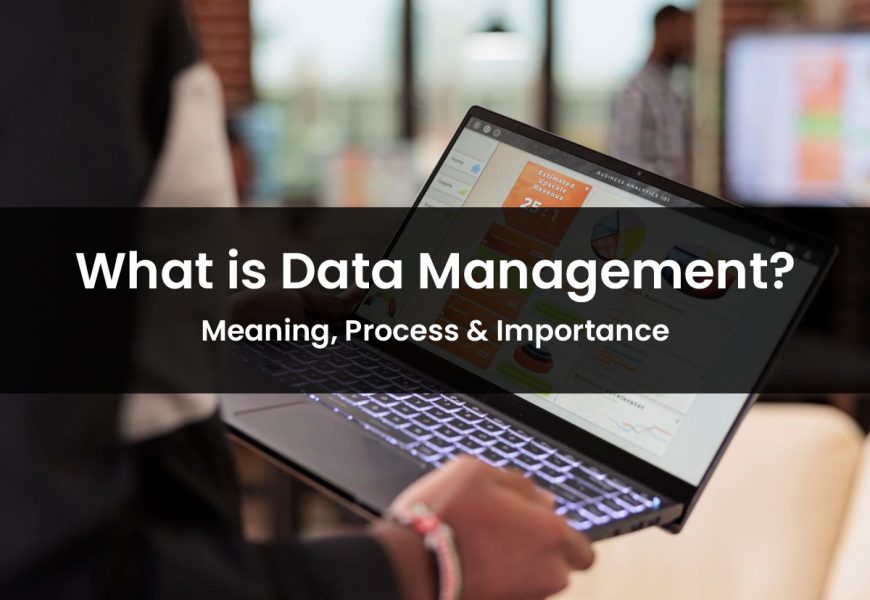The modern world runs on data, and this is not an opinion; it is a fact. Around 72% of the best-performing CEOs believe that the competitive edge favours the company that knows how to use generative AI best. The first step to the most advanced generative AI practises is an information structure that makes data super accessible. This makes the process of data management supremely important.
This article will cover all the important aspects of data management: its benefits, processes, key aspects, and much more.
What is Data Management?
Simply put, data management consists of the collection, processing and utilisation of data securely and effectively that gives greater business results.
Some several roadblocks and challenges hinder the process of effective data management. Challenges like;
- Data volume and silos being scattered across cloud providers and locations
- Different types and formats of data documents, images, and videos).
- Inconsistent and complex datasets limit the utility of the said data
These challenges have made the need for an efficient data management strategy very pertinent, especially for organisations dealing with big data. A flexible and modern data management system seamlessly integrates with existing organisational technology to provide high-quality, actionable data for data scientists, AI and machine learning (ML) engineers, and business users.
A comprehensive data management strategy addresses several key areas:
- Data Collection and Integration: Efficiently collect and integrate data from a variety of sources, including both structured and unstructured data, and across hybrid and multi-cloud environments.
- Data Availability and Resilience: Ensure high data availability and resiliency by implementing robust disaster recovery solutions for data stored in multiple locations.
- Database Management: Develop or acquire databases tailored to specific workload requirements and price-performance needs, optimising data storage and access.
- Data Sharing and Collaboration: Facilitate the sharing of business data and metadata across different organisations to enhance self-service, collaboration, and data accessibility.
- Data Security and Governance: Implement strong security measures and governance practices to comply with regulations and protect data privacy.
- Data Lifecycle Management: Oversee the entire data lifecycle, from creation to deletion, with integrated governance, lineage tracking, observability, and master data management (MDM).
- Automated Data Discovery and Analysis: Leverage generative AI to automate data discovery and analysis, streamlining data management processes.
Why is Data Management So Important?
Data management is crucial because, despite the availability of advanced tools for building generative AI applications, the true value lies in the data itself. High-quality data must be meticulously organized and processed to effectively train AI models. This importance of data management is increasingly evident as the field of generative AI expands.
For instance, during the Championships 2023 at Wimbledon, generative AI provided real-time commentary by accessing data from 130 million documents and 2.7 million contextual data points. Fans using the tournament app or website enjoyed detailed statistics, live play-by-play narration, game commentary, and real-time predictions of match outcomes. This example highlights how a robust data management strategy ensures that valuable data remains accessible, integrated, governed, secure, and accurate, ultimately enhancing the effectiveness and reliability of AI-driven applications.
It Transforms Data Into Assets
Generative AI offers organisations a significant competitive edge, but its effectiveness hinges on the quality of data it utilises. Many organisations still face fundamental data challenges that are amplified by the growing demand for generative AI, which requires increasingly large volumes of data and, thus, more complex data management solutions.
Data is often dispersed across various locations, applications, and cloud environments, creating isolated data silos. The complexity is further heightened by the diverse formats of data, including images, videos, documents, and audio. This variety necessitates more time for data cleaning, integration, and preparation. As a result, many organisations may not fully leverage their data for analytics and AI applications.
However, with modern tools for data architecture, governance, and security, organisations can successfully harness their data to gain valuable insights and make accurate predictions. This capability enhances understanding of customer preferences and improves customer experiences (CX) through data-driven insights. Additionally, it supports the development of innovative data-driven business models, including those reliant on generative AI, which require a solid foundation of high-quality data for effective model training.
Builds a Strong Foundation for Digital Transformation
Data and analytics leaders encounter significant challenges during digital transformation due to the increasing complexity of the data landscape, particularly across hybrid cloud environments. Technologies such as generative AI, machine learning (ML), advanced analytics, Internet of Things (IoT), and automation all depend on vast amounts of data to function effectively. This data needs to be stored, integrated, governed, transformed, and prepared to establish a robust data foundation.
Creating a strong data foundation for AI involves developing an open and trusted data strategy centred on transparency, trust, and collaboration. As highlighted by a Gartner® analyst, “AI-ready data means that your data must be representative of the use case, including all patterns, errors, outliers, and unexpected occurrences needed to train or run the AI model effectively.”
While high-quality data is crucial for AI, it must go beyond traditional analytics standards. AI models require data that is representative of real-world scenarios, including outliers and anomalies, rather than data refined to meet conventional quality metrics.
Promise of Compliant, Governed and Secure Data
Data governance is a critical component of data management. When a data governance team identifies patterns across disparate datasets for integration, they must collaborate with database architecture or engineering teams to define data models and facilitate data flows. For data access, governance teams set policies around access to sensitive data, such as personally identifiable information (PII), while data management teams implement mechanisms to grant access and adjust user roles as needed.
Robust data management practices, including strong data governance, are essential for regulatory compliance. This includes adhering to national and international data privacy regulations, such as the General Data Protection Regulation (GDPR) and the California Consumer Privacy Act (CCPA), as well as industry-specific standards. Establishing comprehensive data management policies and procedures is vital for demonstrating compliance and preparing for audits.
How did Data Management Evolve?
For over five decades, effective data management has been vital in driving business success. From improving the accuracy of information reporting and identifying trends to enabling better decision-making and supporting digital transformation, data has become a crucial asset. Forward-thinking organisations continually seek new ways to leverage data for competitive advantage. Here are some of the latest trends in modern data management that are worth exploring for their relevance to your business and industry:
Data Fabric
Today, many organisations manage various types of data both on-premise and in the cloud, using multiple database management systems, processing technologies, and tools. A data fabric provides a custom solution that combines architecture and technology. By utilising metadata, dynamic data integration, and orchestration, a data fabric enables seamless access to and sharing of data across a distributed environment.
Cloud Data Management
More companies are moving parts or all of their data management platforms to the cloud. Cloud data management offers numerous benefits, including scalability, advanced data security, improved data access, automated backups, disaster recovery, and cost savings. Cloud databases, database-as-a-service (DBaaS) solutions, cloud data warehouses, and cloud data lakes are becoming increasingly popular.
Data as a Product
The concept of “data as a product” involves treating internal data as a key product. The responsibility of data teams, led by a Chief Data Officer or similar executive, is to provide the rest of the organisation with the right data at the right time and of the right quality. The aim is to increase the overall utilisation of data, resulting in more timely and accurate analytical insights.
Augmented Data Management
A newer trend in the field is augmented data management. This approach uses AI and machine learning to make data management processes self-configuring and self-tuning. Augmented data management automates tasks such as data quality management, master data management, and data integration, freeing up skilled technical staff to focus on more strategic activities.
Augmented Analytics
Augmented analytics leverages AI, machine learning, and natural language processing (NLP) to automatically uncover the most important insights. This technology also democratises access to advanced analytics, allowing everyone—not just data scientists—to ask questions about their data and receive answers in a natural, conversational manner.
Key Components of Data Management
Modern data management solutions offer an effective approach to handling data and metadata across a variety of datasets. These advanced systems are designed using the latest data management software and dependable databases or data stores. They often incorporate transactional data lakes, data warehouses, or data lakehouses, all integrated within a data fabric architecture. This architecture supports key functions such as data ingestion, governance, lineage, observability, and master data management. Together, these components form a trusted data foundation, providing high-quality data to data consumers in the form of data products, business intelligence (BI) tools, dashboards, and AI models—encompassing both traditional machine learning and generative AI.
A robust data management strategy generally involves several elements that enhance both strategy and operations across an organisation.
Data Lakes and Architecture
Data can be stored either before or after processing, with the choice of storage repository largely determined by the type of data and its intended use. Relational databases structure data in a tabular format with a fixed schema, while non-relational databases offer more flexibility, lacking a rigid schema.
Relational databases are commonly linked to transactional systems, which execute commands or transactions as a group. A classic example is a bank transfer, where a specified amount is withdrawn from one account and deposited into another. However, to manage structured and unstructured data types, organisations need purpose-built databases catering to a wide range of use cases in analytics, AI, and applications. These databases must support both relational and non-relational formats, including key-value, document, wide-column, graph, and in-memory databases. These multimodal databases natively support diverse data types and modern development models, enabling them to handle various workloads such as IoT, analytics, machine learning, and AI.
Hybrid Cloud Database
Best practices in data management advocate optimising data warehousing for high-performance analytics on structured data. This involves defining a schema tailored to specific data analytics needs, such as dashboards, data visualisation, and other business intelligence tasks. Typically, business users collaborate with data engineers to determine these data requirements, which are then applied to the defined data model.
A data warehouse is usually organised as a relational system that stores structured data sourced from transactional databases. For unstructured and semi-structured data, data lakes are used to aggregate data from both relational and non-relational systems. Data lakes are often favoured for their cost-effectiveness, offering a storage environment capable of holding petabytes of raw data at a low cost.
Data lakes are particularly advantageous for data scientists, as they allow the integration of both structured and unstructured data into their projects. However, both data warehouses and data lakes have their limitations. In data warehouses, proprietary data formats and high storage costs can hinder collaboration and deployment of AI and machine learning models.
On the other hand, data lakes face challenges in extracting insights in a governed and efficient manner. The open data lakehouse model overcomes these challenges by supporting multiple open formats on cloud object storage. It combines data from various sources, including existing repositories, to facilitate large-scale analytics and AI.
The adoption of multi-cloud and hybrid strategies is on the rise, driven by the need for AI technologies to process vast amounts of data. These data sets require modern data stores built on cloud-native architectures, which offer scalability, cost optimisation, enhanced performance, and business continuity. Gartner predicts that by the end of 2026, “90% of data management tools and platforms that do not support multi-cloud and hybrid capabilities will be decommissioned.”
While current tools help database administrators (DBAs) automate many traditional management tasks, manual intervention is still often required due to the complexity and scale of database environments. This manual involvement increases the risk of errors, making it a priority to reduce the need for hands-on data management in operating databases as fully managed services.
Fully managed cloud databases automate labour-intensive tasks such as upgrades, backups, patching, and maintenance. This automation frees DBAs to focus on higher-value activities, like schema optimisation, developing cloud-native applications, and supporting new AI use cases. Unlike on-premises deployments, cloud storage providers allow users to quickly scale large clusters, paying only for the resources they use. This means organisations can increase computing power to complete tasks in hours rather than days simply by purchasing additional compute nodes on a cloud platform.
This shift towards cloud data platforms is also driving the adoption of streaming data processing. Tools like Apache Kafka enable real-time data processing, allowing consumers to receive data within seconds by subscribing to specific topics. However, batch processing remains valuable for its efficiency in handling large data volumes. Since batch processing follows a set schedule—daily, weekly, or monthly—it is ideal for generating business performance dashboards, which typically do not require real-time data.
Data Fabric
The growing complexity of data management has led to the emergence of data fabrics. Data fabrics use intelligent and automated systems to enable end-to-end integration of data pipelines and cloud environments. They also streamline the delivery of quality data and provide a framework for enforcing data governance policies, ensuring compliance. Connecting data across organisational silos allows businesses to gain a more comprehensive view of business performance. This unification of data from HR, marketing, sales, supply chain, and other areas gives leaders more profound insights into their customers.
A data mesh offers another approach to data architecture. While a data fabric facilitates end-to-end integration, a data mesh is a decentralised architecture that organises data by specific business domains, such as marketing, sales, and customer service. This structure gives more ownership to the producers of each dataset, fostering greater accountability and alignment with business needs.
Data Processing and Integration
Data Integration and Processing
In this phase of the data management lifecycle, raw data is gathered from a variety of sources, including web APIs, mobile apps, Internet of Things (IoT) devices, forms, surveys, and more. Once collected, the data is typically processed or loaded using data integration techniques such as extract, transform, load (ETL) or extract, load, transform (ELT). ETL has traditionally been the standard approach for integrating and organising data across different datasets, but ELT has gained popularity with the rise of cloud data platforms and the growing demand for real-time data.
Beyond batch processing, data replication offers another method for integrating data. This involves synchronising data from a source location to one or more target locations, ensuring data availability, reliability, and resilience. Technologies like change data capture (CDC) use log-based replication to track changes made to data at the source and propagate them to target systems, enabling organisations to make decisions based on the most current information.
Regardless of the data integration technique used, during the data processing stage, the data is usually filtered, merged, or aggregated to meet the specific requirements of its intended application. These applications can range from business intelligence dashboards to predictive machine learning algorithms.
Employing continuous integration and continuous deployment (CI/CD) for version control allows data teams to track changes to both code and data assets. Version control enhances collaboration, enabling team members to work on different aspects of a project simultaneously and merge their changes without conflicts.
Data Governance and Metadata Management
Data governance ensures the availability and proper use of data across an organisation. To maintain compliance, data governance encompasses processes, policies, and tools related to data quality, access, usability, and security. For example, data governance councils often align taxonomies to ensure consistent metadata application across various data sources. A data catalogue further documents this taxonomy, making data more accessible to users and promoting data democratisation within the organisation.
Adding the correct business context to data is crucial for the automated enforcement of data governance policies and maintaining data quality. Service level agreement (SLA) rules play a key role here, ensuring that data is both protected and of the necessary quality. Understanding the provenance of data and gaining transparency into its journey through data pipelines is also essential. Robust data lineage capabilities are necessary to provide visibility as data moves from its source to the end users. Data governance teams also establish roles and responsibilities to ensure appropriate data access, which is vital for maintaining data privacy.
Data Security
Data Security is a guardrail that protects digital information from curroption, unauthorised acces and theft. Digital economy’s role has increasingly grown in our lives, raising the scrutiny one needs to place upon today’s businesses. However, this scrutiny becomes important when we talk about protecting customer data or to avoid instances that would need disaster recovery.
Though data losses can have a great nehgative impact on a any business, data breaches can completely wreck a company from a brand and a financial standpoint. These worries can be evaded by the implication of encryption and data masking in the security strategy by the data security teams.
Data Observability
This process can be describes as a the method where data is monitored, managed and maintained to help and promise its quality, reliability and availability for multiple processes, systems and/or pipelines that exist in a company. To draw a random analogy for day to day life, data observability is a lot like the practise of medicine. It ensures the health of a company’s data and its position in a data ecosystem.
However, it cannot be limited to simply traditional monitoring, where the only aim is to describe the problem. Data observability can help one find, troubleshoot and settle data-related issues in real time.
MDM (Master Data Management)
Master data management (MDM) helps create a single, accurate view of key business information, such as details about products, customers, employees, and suppliers. By ensuring that this core data is correct and consistent, MDM allows businesses to gain quicker insights, improve data quality, and stay compliant with regulations. With a complete, 360-degree view of their important data, companies can better analyse their business, identify their most successful products and markets, and understand who their most valuable customers are.
Advantages of Data Management
Organisations benefit in various ways when they implement and sustain data management initiatives.
- Elimination of Data Silos: Many companies unintentionally create isolated data pockets within their operations. Modern data management solutions, such as data fabrics and data lakes, help to dismantle these silos and reduce dependence on specific data owners. Data fabrics uncover potential links between different datasets across departments like human resources, marketing, and sales. On the other hand, data lakes aggregate raw data from these departments, centralising data access and reducing the need for single points of ownership.
- Enhanced Compliance and Security: Governance councils put safeguards in place to protect companies from fines and reputational damage that can result from failing to adhere to government regulations. Missteps in this area can have significant financial and brand consequences.
- Improved Customer Experience: Although this benefit may not be immediately apparent, successful data management can lead to a better user experience. It enables teams to conduct more comprehensive analyses, allowing for a deeper understanding and personalisation of the customer journey.
- Scalability: Data management plays a crucial role in supporting business growth, but the extent of this support depends on the technology and processes utilised. Cloud platforms, for example, offer flexibility by allowing data owners to adjust computing resources up or down as needed.
Components of New Data Management
In the past decade, advancements in hybrid cloud, artificial intelligence (AI), the Internet of Things (IoT), and edge computing have significantly increased the complexity of big data management. As a result, new tools and components have emerged to enhance data management capabilities. Here are some of the latest developments:
- Augmented Data Management: This is becoming increasingly popular as it further enhances data management capabilities. This approach, powered by AI, machine learning (ML), data automation, data fabric, and data mesh, falls under the umbrella of augmented intelligence. It allows data owners to create data products like catalogues of data assets, making it easier to search for and find data products, and to use APIs for querying visuals and data products. Additionally, insights from data fabric metadata can automate tasks by learning from patterns during the creation of data products or during the monitoring process of these products.
- Generative AI: Generative AI tools, like IBM® watsonx.data™, enable organisations to efficiently unify, curate, and prepare data for AI models and applications. Integrated vectorised embedding capabilities support retrieval-augmented generation (RAG) use cases at scale, allowing for more effective use of large sets of trusted and governed data.
- Hybrid Cloud Deployments: Hybrid cloud deployments simplify application connectivity and security across different platforms, clusters, and clouds. Thanks to containers and object storage, computing and data have become more portable, making it easier to deploy and move applications between environments.
- Semantic Layer: To speed up data access and unlock new insights without requiring SQL, organisations are creating AI-powered semantic layers. This metadata and abstraction layer is built on top of the organisation’s source data, such as data lakes or warehouses. The metadata enriches the data model and is designed to be clear enough for business users to understand.
- Shared Metadata Layer: A shared metadata layer enables organisations to access data across hybrid cloud environments through a single point of entry, connecting storage and analytics environments both in the cloud and on-premises. Multiple query engines can be used to optimise analytics and AI workloads.
Creating a shared metadata layer in a data lakehouse is considered best practice, as it helps in cataloguing and sharing data. This layer accelerates the discovery and enrichment of data, the analysis of data from multiple sources, and the running of various workloads and use cases.
Additionally, a shared metadata management tool simplifies the management of objects in a shared repository. It allows for the easy addition of new host systems, databases, data files, or schemas, as well as the deletion of items from the shared repository.
Challenges in Data Management
Many of the challenges in data management today arise from the rapid pace of business and the vast increase in data. As data continues to grow in variety, speed, and volume, organisations are under pressure to find more effective management tools. Here are some of the key challenges they face:
- Insufficient Data Insight: Organisations are collecting data from a growing number of sources, such as sensors, smart devices, social media, and video cameras. However, this data is of little use if they don’t know what data they have, where it’s located, or how to use it. Effective data management solutions must scale and perform well to provide timely and meaningful insights.
- Maintaining Data-Management Performance: As organisations continually capture and use more data, keeping performance levels high becomes a challenge. To maintain fast response times, they need to constantly monitor the types of queries being made and adjust indexes accordingly, without compromising performance.
- Complying with Changing Data Regulations: Data compliance is a complex and ever-changing landscape, with regulations varying across different jurisdictions. Organisations must be able to easily review their data to identify any information that falls under new or updated rules. This is especially important for personally identifiable information (PII), which needs to be detected, tracked, and managed to meet stringent global privacy standards.
- Processing and Converting Data Efficiently: Collecting data is only the first step; the real value comes from processing it. If converting data for analysis is time-consuming and difficult, organisations may miss out on the insights it could offer. Therefore, data must be easily processed and converted to ensure its value is realised.
- Effective Data Storage: In modern data management, organisations store data across multiple systems, including structured data warehouses and unstructured data lakes, which can store any type of data in a single repository. Data scientists need a way to quickly and easily transform this data into the format or model required for various analyses.
- Optimising IT Agility and Costs: With cloud data management systems, organisations can choose to keep and analyse data on-premises, in the cloud, or through a hybrid approach. IT teams must assess the consistency between on-premises and cloud environments to maintain flexibility and reduce costs.
Best Practices for Data Management
Addressing data management challenges effectively requires a thoughtful approach and the implementation of best practices. While these practices can vary by data type and industry, they generally address the core issues organisations face today. Here are some key best practices:
- Discovery Layer to Identify Data: A discovery layer placed on top of your data systems allows analysts and data scientists to search for and browse datasets easily. This makes it easier to locate and use data across your organisation.
- Data Science Environment for Efficient Data Repurposing: Creating a data science environment that automates data transformation tasks helps streamline the creation and testing of data models. Tools that automatically handle data transformation can help organisations speed up developing and evaluating new models.
- Autonomous Technology to Maintain Performance: Autonomous data technology leverages AI and machine learning to continuously monitor and optimise database queries and indexes. This helps maintain fast response times and reduces the need for database administrators and data scientists to make manual adjustments.
- Discovery Tools for Compliance: New data discovery tools can review and trace data connections to ensure compliance with various regulations. As global compliance requirements become more stringent, these tools are crucial for risk and security officers to manage and monitor compliance effectively.
- A Converged Database: A converged database supports all modern data types and development models within a single system. The best-converged databases can handle a variety of workloads, including graph processing, IoT data, blockchain, and machine learning tasks.
- Database Platform That Supports Performance, Scale, and Availability: You need a scalable and high-performance database platform to analyse data effectively and make timely decisions. This enables quick analysis of data from multiple sources, supports advanced analytics, and enhances decision-making processes.
- Common Query Layer for Diverse Data Storage: Modern technologies allow different data management systems to work seamlessly together. A common query layer that spans various data storage solutions enables data scientists, analysts, and applications to access and use data without needing to know its exact location or manually transform it into a usable format.
FAQs about Data Management
What are the four types of data management?
The four main types of data management systems include:
- Customer Relationship Management (CRM) Systems: Tools that manage interactions with current and potential customers.
- Marketing Technology Systems: Platforms that help manage and analyse marketing campaigns and customer data.
- Data Warehouse Systems: Central repositories for storing, managing, and analysing large volumes of data from multiple sources.
- Analytics Tools: Software used to process and analyse data to gain insights and inform decision-making.
What are examples of data management?
Examples of data management include:
- Customer Data Management
- Healthcare Data Management
- Financial Data Management
- Risk Management Data
- Business Intelligence Data Management
- Security Data Management
- Employee/HR Data Management
- Marketing Data Management
What are the 4 steps of data management?
The four key steps of data management are:
- Strategy and Governance: Establishing a clear strategy and governance framework for data management.
- Standards: Defining and maintaining data standards to ensure consistency and quality.
- Integration: Ensuring seamless integration of data across different systems and platforms.
- Quality: Continuously monitoring and improving data quality to support reliable decision-making.
What is a data management tool?
A data management tool is a software solution designed to help businesses manage their data throughout its lifecycle. These tools ensure data is accurate, consistent, secure, and compliant, making it analysis-ready for decision-making and business intelligence initiatives.
Why is data management important?
Data management is crucial because it ensures that the data your business relies on is organised, secure, and accurate throughout its lifecycle. This process is essential for making informed decisions, staying compliant with regulations, and protecting consumer privacy.















